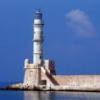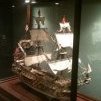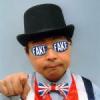-
Posts
1,197 -
Joined
-
Last visited
Reputation Activity
-
 Stuntflyer got a reaction from KARAVOKIRIS in Sloop Speedwell 1752 by Stuntflyer (Mike) - Ketch Rigged Sloop - POF
Stuntflyer got a reaction from KARAVOKIRIS in Sloop Speedwell 1752 by Stuntflyer (Mike) - Ketch Rigged Sloop - POF
I've been working on a number of things lately. .
The two inner stern frames where in need of some shortening as they were well above the top edge of the transom. I used a fine saw to make the cuts. I believe it's called a JLC razor Saw.
Then I added the 3/32" cap rail to the bow section. Actually, these were taken down with the thickness sander slightly thinner than 3/32". I did this so the top edge of the scroll molding would align with the cap rail in a smooth contour along the shear.
Then I scraped the 1/32" x 3/32" fancy molding for the outer hull. I went with a simple shape here.
Lower platforms (fore)
I went with Chuck's design for the Gauge which is needed when setting the depth of the beams inside the hull. What can I say other than it was easy to make and it worked perfectly.
The disc sander really comes in handy when making these beams, especially since they are boxwood. To establish the angles for each beam, I used a slightly shorter one than needed from scrap wood. Being shorter, I could hold it against one side of the hull and approximate the angles needed. Adjustments were made to the disc sander until I was sure that the final beam would work. For the most part things went smoothly with only a few throwaways. keep in mind that the beams should not only sit nicely against the frames, but also the tops should lay flat to one another for the planking.
Mike
-
 Stuntflyer got a reaction from scrubbyj427 in Sloop Speedwell 1752 by Stuntflyer (Mike) - Ketch Rigged Sloop - POF
Stuntflyer got a reaction from scrubbyj427 in Sloop Speedwell 1752 by Stuntflyer (Mike) - Ketch Rigged Sloop - POF
I've been working on a number of things lately. .
The two inner stern frames where in need of some shortening as they were well above the top edge of the transom. I used a fine saw to make the cuts. I believe it's called a JLC razor Saw.
Then I added the 3/32" cap rail to the bow section. Actually, these were taken down with the thickness sander slightly thinner than 3/32". I did this so the top edge of the scroll molding would align with the cap rail in a smooth contour along the shear.
Then I scraped the 1/32" x 3/32" fancy molding for the outer hull. I went with a simple shape here.
Lower platforms (fore)
I went with Chuck's design for the Gauge which is needed when setting the depth of the beams inside the hull. What can I say other than it was easy to make and it worked perfectly.
The disc sander really comes in handy when making these beams, especially since they are boxwood. To establish the angles for each beam, I used a slightly shorter one than needed from scrap wood. Being shorter, I could hold it against one side of the hull and approximate the angles needed. Adjustments were made to the disc sander until I was sure that the final beam would work. For the most part things went smoothly with only a few throwaways. keep in mind that the beams should not only sit nicely against the frames, but also the tops should lay flat to one another for the planking.
Mike
-
 Stuntflyer got a reaction from KentM in Sloop Speedwell 1752 by Stuntflyer (Mike) - Ketch Rigged Sloop - POF
Stuntflyer got a reaction from KentM in Sloop Speedwell 1752 by Stuntflyer (Mike) - Ketch Rigged Sloop - POF
I've been working on a number of things lately. .
The two inner stern frames where in need of some shortening as they were well above the top edge of the transom. I used a fine saw to make the cuts. I believe it's called a JLC razor Saw.
Then I added the 3/32" cap rail to the bow section. Actually, these were taken down with the thickness sander slightly thinner than 3/32". I did this so the top edge of the scroll molding would align with the cap rail in a smooth contour along the shear.
Then I scraped the 1/32" x 3/32" fancy molding for the outer hull. I went with a simple shape here.
Lower platforms (fore)
I went with Chuck's design for the Gauge which is needed when setting the depth of the beams inside the hull. What can I say other than it was easy to make and it worked perfectly.
The disc sander really comes in handy when making these beams, especially since they are boxwood. To establish the angles for each beam, I used a slightly shorter one than needed from scrap wood. Being shorter, I could hold it against one side of the hull and approximate the angles needed. Adjustments were made to the disc sander until I was sure that the final beam would work. For the most part things went smoothly with only a few throwaways. keep in mind that the beams should not only sit nicely against the frames, but also the tops should lay flat to one another for the planking.
Mike
-
 Stuntflyer got a reaction from mtaylor in Sloop Speedwell 1752 by Stuntflyer (Mike) - Ketch Rigged Sloop - POF
Stuntflyer got a reaction from mtaylor in Sloop Speedwell 1752 by Stuntflyer (Mike) - Ketch Rigged Sloop - POF
I've been working on a number of things lately. .
The two inner stern frames where in need of some shortening as they were well above the top edge of the transom. I used a fine saw to make the cuts. I believe it's called a JLC razor Saw.
Then I added the 3/32" cap rail to the bow section. Actually, these were taken down with the thickness sander slightly thinner than 3/32". I did this so the top edge of the scroll molding would align with the cap rail in a smooth contour along the shear.
Then I scraped the 1/32" x 3/32" fancy molding for the outer hull. I went with a simple shape here.
Lower platforms (fore)
I went with Chuck's design for the Gauge which is needed when setting the depth of the beams inside the hull. What can I say other than it was easy to make and it worked perfectly.
The disc sander really comes in handy when making these beams, especially since they are boxwood. To establish the angles for each beam, I used a slightly shorter one than needed from scrap wood. Being shorter, I could hold it against one side of the hull and approximate the angles needed. Adjustments were made to the disc sander until I was sure that the final beam would work. For the most part things went smoothly with only a few throwaways. keep in mind that the beams should not only sit nicely against the frames, but also the tops should lay flat to one another for the planking.
Mike
-
 Stuntflyer got a reaction from Seventynet in Sloop Speedwell 1752 by Stuntflyer (Mike) - Ketch Rigged Sloop - POF
Stuntflyer got a reaction from Seventynet in Sloop Speedwell 1752 by Stuntflyer (Mike) - Ketch Rigged Sloop - POF
I've been working on a number of things lately. .
The two inner stern frames where in need of some shortening as they were well above the top edge of the transom. I used a fine saw to make the cuts. I believe it's called a JLC razor Saw.
Then I added the 3/32" cap rail to the bow section. Actually, these were taken down with the thickness sander slightly thinner than 3/32". I did this so the top edge of the scroll molding would align with the cap rail in a smooth contour along the shear.
Then I scraped the 1/32" x 3/32" fancy molding for the outer hull. I went with a simple shape here.
Lower platforms (fore)
I went with Chuck's design for the Gauge which is needed when setting the depth of the beams inside the hull. What can I say other than it was easy to make and it worked perfectly.
The disc sander really comes in handy when making these beams, especially since they are boxwood. To establish the angles for each beam, I used a slightly shorter one than needed from scrap wood. Being shorter, I could hold it against one side of the hull and approximate the angles needed. Adjustments were made to the disc sander until I was sure that the final beam would work. For the most part things went smoothly with only a few throwaways. keep in mind that the beams should not only sit nicely against the frames, but also the tops should lay flat to one another for the planking.
Mike
-
 Stuntflyer got a reaction from bdgiantman2 in Sloop Speedwell 1752 by Stuntflyer (Mike) - Ketch Rigged Sloop - POF
Stuntflyer got a reaction from bdgiantman2 in Sloop Speedwell 1752 by Stuntflyer (Mike) - Ketch Rigged Sloop - POF
I've been working on a number of things lately. .
The two inner stern frames where in need of some shortening as they were well above the top edge of the transom. I used a fine saw to make the cuts. I believe it's called a JLC razor Saw.
Then I added the 3/32" cap rail to the bow section. Actually, these were taken down with the thickness sander slightly thinner than 3/32". I did this so the top edge of the scroll molding would align with the cap rail in a smooth contour along the shear.
Then I scraped the 1/32" x 3/32" fancy molding for the outer hull. I went with a simple shape here.
Lower platforms (fore)
I went with Chuck's design for the Gauge which is needed when setting the depth of the beams inside the hull. What can I say other than it was easy to make and it worked perfectly.
The disc sander really comes in handy when making these beams, especially since they are boxwood. To establish the angles for each beam, I used a slightly shorter one than needed from scrap wood. Being shorter, I could hold it against one side of the hull and approximate the angles needed. Adjustments were made to the disc sander until I was sure that the final beam would work. For the most part things went smoothly with only a few throwaways. keep in mind that the beams should not only sit nicely against the frames, but also the tops should lay flat to one another for the planking.
Mike
-
 Stuntflyer got a reaction from tmj in Sloop Speedwell 1752 by Stuntflyer (Mike) - Ketch Rigged Sloop - POF
Stuntflyer got a reaction from tmj in Sloop Speedwell 1752 by Stuntflyer (Mike) - Ketch Rigged Sloop - POF
I've been working on a number of things lately. .
The two inner stern frames where in need of some shortening as they were well above the top edge of the transom. I used a fine saw to make the cuts. I believe it's called a JLC razor Saw.
Then I added the 3/32" cap rail to the bow section. Actually, these were taken down with the thickness sander slightly thinner than 3/32". I did this so the top edge of the scroll molding would align with the cap rail in a smooth contour along the shear.
Then I scraped the 1/32" x 3/32" fancy molding for the outer hull. I went with a simple shape here.
Lower platforms (fore)
I went with Chuck's design for the Gauge which is needed when setting the depth of the beams inside the hull. What can I say other than it was easy to make and it worked perfectly.
The disc sander really comes in handy when making these beams, especially since they are boxwood. To establish the angles for each beam, I used a slightly shorter one than needed from scrap wood. Being shorter, I could hold it against one side of the hull and approximate the angles needed. Adjustments were made to the disc sander until I was sure that the final beam would work. For the most part things went smoothly with only a few throwaways. keep in mind that the beams should not only sit nicely against the frames, but also the tops should lay flat to one another for the planking.
Mike
-
 Stuntflyer got a reaction from Alexander Bulimov in Sloop Speedwell 1752 by Stuntflyer (Mike) - Ketch Rigged Sloop - POF
Stuntflyer got a reaction from Alexander Bulimov in Sloop Speedwell 1752 by Stuntflyer (Mike) - Ketch Rigged Sloop - POF
I've been working on a number of things lately. .
The two inner stern frames where in need of some shortening as they were well above the top edge of the transom. I used a fine saw to make the cuts. I believe it's called a JLC razor Saw.
Then I added the 3/32" cap rail to the bow section. Actually, these were taken down with the thickness sander slightly thinner than 3/32". I did this so the top edge of the scroll molding would align with the cap rail in a smooth contour along the shear.
Then I scraped the 1/32" x 3/32" fancy molding for the outer hull. I went with a simple shape here.
Lower platforms (fore)
I went with Chuck's design for the Gauge which is needed when setting the depth of the beams inside the hull. What can I say other than it was easy to make and it worked perfectly.
The disc sander really comes in handy when making these beams, especially since they are boxwood. To establish the angles for each beam, I used a slightly shorter one than needed from scrap wood. Being shorter, I could hold it against one side of the hull and approximate the angles needed. Adjustments were made to the disc sander until I was sure that the final beam would work. For the most part things went smoothly with only a few throwaways. keep in mind that the beams should not only sit nicely against the frames, but also the tops should lay flat to one another for the planking.
Mike
-
 Stuntflyer got a reaction from cotrecerf in Sloop Speedwell 1752 by Stuntflyer (Mike) - Ketch Rigged Sloop - POF
Stuntflyer got a reaction from cotrecerf in Sloop Speedwell 1752 by Stuntflyer (Mike) - Ketch Rigged Sloop - POF
I've been working on a number of things lately. .
The two inner stern frames where in need of some shortening as they were well above the top edge of the transom. I used a fine saw to make the cuts. I believe it's called a JLC razor Saw.
Then I added the 3/32" cap rail to the bow section. Actually, these were taken down with the thickness sander slightly thinner than 3/32". I did this so the top edge of the scroll molding would align with the cap rail in a smooth contour along the shear.
Then I scraped the 1/32" x 3/32" fancy molding for the outer hull. I went with a simple shape here.
Lower platforms (fore)
I went with Chuck's design for the Gauge which is needed when setting the depth of the beams inside the hull. What can I say other than it was easy to make and it worked perfectly.
The disc sander really comes in handy when making these beams, especially since they are boxwood. To establish the angles for each beam, I used a slightly shorter one than needed from scrap wood. Being shorter, I could hold it against one side of the hull and approximate the angles needed. Adjustments were made to the disc sander until I was sure that the final beam would work. For the most part things went smoothly with only a few throwaways. keep in mind that the beams should not only sit nicely against the frames, but also the tops should lay flat to one another for the planking.
Mike
-
 Stuntflyer reacted to glbarlow in HMS Winchelsea 1764 by westwood - 1:48
Stuntflyer reacted to glbarlow in HMS Winchelsea 1764 by westwood - 1:48
Very nice and well done. Lots of small parts to line up and fit.
-
 Stuntflyer got a reaction from yvesvidal in Sloop Speedwell 1752 by Stuntflyer (Mike) - Ketch Rigged Sloop - POF
Stuntflyer got a reaction from yvesvidal in Sloop Speedwell 1752 by Stuntflyer (Mike) - Ketch Rigged Sloop - POF
Hull Planking, cont. .
It seems like forever since my last post. I had some personal matters to attend to amongst a few other things. Anyway, I'm looking forward to getting things back up to speed.
I'm working on a tricky part of the hull planking, those cutouts around the gun ports and sweep port lids. I really had to take my time here in order to avoid re-dos. The reveal around the gun ports is somewhere between 1/64"-1/32". A pillar file comes in really handy. It only cuts on one edge thus allowing for clean corner cuts. https://contenti.com/grobet-extra-narrow-pillar-files I use either a "0" and "2" cut.
I haven't done any sanding on the planking and as you can see it's a bit of a mess. The red color is Winsor & Newton "Crimson". In the past I would add a bit of Burnt Umber in order to darken the color. The two colors would often separate which I found to be a pain, so I decided to keep it simple this time around.
Mike
-
 Stuntflyer got a reaction from FrankWouts in HMS Winchelsea 1764 by Trussben - FINISHED - 1:48
Stuntflyer got a reaction from FrankWouts in HMS Winchelsea 1764 by Trussben - FINISHED - 1:48
Nice, Ben!
-
 Stuntflyer got a reaction from KARAVOKIRIS in Sloop Speedwell 1752 by Stuntflyer (Mike) - Ketch Rigged Sloop - POF
Stuntflyer got a reaction from KARAVOKIRIS in Sloop Speedwell 1752 by Stuntflyer (Mike) - Ketch Rigged Sloop - POF
I had to add the two outer stern lights before doing anymore work on the upper bulwark strakes. They are much stronger than the laser cut wooden ones that were on the Winnie. Before installing them I wanted to remove the char color from the inside edges of transom template. Sanding was not an option, so I mixed up some paint with what seemed to be a reasonable color. Notice the reflection off the build board on the center light.
I have the upper port side strakes completed. Cut from a long 3/64" sheet, I was able to combine strakes #3 and #5 together which made things easier for me when adding it to the hull. I was happy to see that the strake edge ran smoothly along the gun ports. It's hard to see, but there is a 1/64" space between the shear and the top of the transom. This allows for the cap rail to sit even with or slightly below the top of the transom, rather than above it. I planned for this in advance which might be something that you would consider doing. I sandwiched Three of those laser cut scroll pieces together rather than two which gives me more leeway as I add them to the hull.
Mike
-
 Stuntflyer reacted to Erik W in HM Cutter Cheerful 1806 by Erik W - 1:48 scale
Stuntflyer reacted to Erik W in HM Cutter Cheerful 1806 by Erik W - 1:48 scale
Thanks for all the likes on my last post. For this week I finished the bow cannons, made the 12 quoin handles, and drilled and added the extra bolts on the gun carriages. Since these will all be painted I went ahead and used .020" styrene rod. It's easier to work with and cut than wire. The bolts stand proud of the surface by .010", which looks good to my eye. I made a quick jig out of .010" thick styrene, and then cut the bolt heads flush with my superb PBL flush cutters (one of the highest quality, best tools I own, and sadly long discontinued - the cutting surface edges are very precise and produce an absolutely perfect flush cut). The last step before the carriages will be painted is to drill the eye bolt holes (with the eye bolts to be added at a later time) and do a bit of clean up and filling where needed.
This will probably be my last update for some time. I have family coming into town next week, and then I head off to Hokkaido, Japan to explore for a while.
Erik
-
 Stuntflyer got a reaction from KentM in Sloop Speedwell 1752 by Stuntflyer (Mike) - Ketch Rigged Sloop - POF
Stuntflyer got a reaction from KentM in Sloop Speedwell 1752 by Stuntflyer (Mike) - Ketch Rigged Sloop - POF
I had to add the two outer stern lights before doing anymore work on the upper bulwark strakes. They are much stronger than the laser cut wooden ones that were on the Winnie. Before installing them I wanted to remove the char color from the inside edges of transom template. Sanding was not an option, so I mixed up some paint with what seemed to be a reasonable color. Notice the reflection off the build board on the center light.
I have the upper port side strakes completed. Cut from a long 3/64" sheet, I was able to combine strakes #3 and #5 together which made things easier for me when adding it to the hull. I was happy to see that the strake edge ran smoothly along the gun ports. It's hard to see, but there is a 1/64" space between the shear and the top of the transom. This allows for the cap rail to sit even with or slightly below the top of the transom, rather than above it. I planned for this in advance which might be something that you would consider doing. I sandwiched Three of those laser cut scroll pieces together rather than two which gives me more leeway as I add them to the hull.
Mike
-
 Stuntflyer got a reaction from bdgiantman2 in Sloop Speedwell 1752 by Stuntflyer (Mike) - Ketch Rigged Sloop - POF
Stuntflyer got a reaction from bdgiantman2 in Sloop Speedwell 1752 by Stuntflyer (Mike) - Ketch Rigged Sloop - POF
I had to add the two outer stern lights before doing anymore work on the upper bulwark strakes. They are much stronger than the laser cut wooden ones that were on the Winnie. Before installing them I wanted to remove the char color from the inside edges of transom template. Sanding was not an option, so I mixed up some paint with what seemed to be a reasonable color. Notice the reflection off the build board on the center light.
I have the upper port side strakes completed. Cut from a long 3/64" sheet, I was able to combine strakes #3 and #5 together which made things easier for me when adding it to the hull. I was happy to see that the strake edge ran smoothly along the gun ports. It's hard to see, but there is a 1/64" space between the shear and the top of the transom. This allows for the cap rail to sit even with or slightly below the top of the transom, rather than above it. I planned for this in advance which might be something that you would consider doing. I sandwiched Three of those laser cut scroll pieces together rather than two which gives me more leeway as I add them to the hull.
Mike
-
 Stuntflyer got a reaction from tmj in Sloop Speedwell 1752 by Stuntflyer (Mike) - Ketch Rigged Sloop - POF
Stuntflyer got a reaction from tmj in Sloop Speedwell 1752 by Stuntflyer (Mike) - Ketch Rigged Sloop - POF
I had to add the two outer stern lights before doing anymore work on the upper bulwark strakes. They are much stronger than the laser cut wooden ones that were on the Winnie. Before installing them I wanted to remove the char color from the inside edges of transom template. Sanding was not an option, so I mixed up some paint with what seemed to be a reasonable color. Notice the reflection off the build board on the center light.
I have the upper port side strakes completed. Cut from a long 3/64" sheet, I was able to combine strakes #3 and #5 together which made things easier for me when adding it to the hull. I was happy to see that the strake edge ran smoothly along the gun ports. It's hard to see, but there is a 1/64" space between the shear and the top of the transom. This allows for the cap rail to sit even with or slightly below the top of the transom, rather than above it. I planned for this in advance which might be something that you would consider doing. I sandwiched Three of those laser cut scroll pieces together rather than two which gives me more leeway as I add them to the hull.
Mike
-
 Stuntflyer got a reaction from Mike Y in Sloop Speedwell 1752 by Stuntflyer (Mike) - Ketch Rigged Sloop - POF
Stuntflyer got a reaction from Mike Y in Sloop Speedwell 1752 by Stuntflyer (Mike) - Ketch Rigged Sloop - POF
I had to add the two outer stern lights before doing anymore work on the upper bulwark strakes. They are much stronger than the laser cut wooden ones that were on the Winnie. Before installing them I wanted to remove the char color from the inside edges of transom template. Sanding was not an option, so I mixed up some paint with what seemed to be a reasonable color. Notice the reflection off the build board on the center light.
I have the upper port side strakes completed. Cut from a long 3/64" sheet, I was able to combine strakes #3 and #5 together which made things easier for me when adding it to the hull. I was happy to see that the strake edge ran smoothly along the gun ports. It's hard to see, but there is a 1/64" space between the shear and the top of the transom. This allows for the cap rail to sit even with or slightly below the top of the transom, rather than above it. I planned for this in advance which might be something that you would consider doing. I sandwiched Three of those laser cut scroll pieces together rather than two which gives me more leeway as I add them to the hull.
Mike
-
 Stuntflyer got a reaction from Freebird in Sloop Speedwell 1752 by Stuntflyer (Mike) - Ketch Rigged Sloop - POF
Stuntflyer got a reaction from Freebird in Sloop Speedwell 1752 by Stuntflyer (Mike) - Ketch Rigged Sloop - POF
I had to add the two outer stern lights before doing anymore work on the upper bulwark strakes. They are much stronger than the laser cut wooden ones that were on the Winnie. Before installing them I wanted to remove the char color from the inside edges of transom template. Sanding was not an option, so I mixed up some paint with what seemed to be a reasonable color. Notice the reflection off the build board on the center light.
I have the upper port side strakes completed. Cut from a long 3/64" sheet, I was able to combine strakes #3 and #5 together which made things easier for me when adding it to the hull. I was happy to see that the strake edge ran smoothly along the gun ports. It's hard to see, but there is a 1/64" space between the shear and the top of the transom. This allows for the cap rail to sit even with or slightly below the top of the transom, rather than above it. I planned for this in advance which might be something that you would consider doing. I sandwiched Three of those laser cut scroll pieces together rather than two which gives me more leeway as I add them to the hull.
Mike
-
 Stuntflyer got a reaction from ERS Rich in Sloop Speedwell 1752 by Stuntflyer (Mike) - Ketch Rigged Sloop - POF
Stuntflyer got a reaction from ERS Rich in Sloop Speedwell 1752 by Stuntflyer (Mike) - Ketch Rigged Sloop - POF
I had to add the two outer stern lights before doing anymore work on the upper bulwark strakes. They are much stronger than the laser cut wooden ones that were on the Winnie. Before installing them I wanted to remove the char color from the inside edges of transom template. Sanding was not an option, so I mixed up some paint with what seemed to be a reasonable color. Notice the reflection off the build board on the center light.
I have the upper port side strakes completed. Cut from a long 3/64" sheet, I was able to combine strakes #3 and #5 together which made things easier for me when adding it to the hull. I was happy to see that the strake edge ran smoothly along the gun ports. It's hard to see, but there is a 1/64" space between the shear and the top of the transom. This allows for the cap rail to sit even with or slightly below the top of the transom, rather than above it. I planned for this in advance which might be something that you would consider doing. I sandwiched Three of those laser cut scroll pieces together rather than two which gives me more leeway as I add them to the hull.
Mike
-
 Stuntflyer got a reaction from fake johnbull in Sloop Speedwell 1752 by Stuntflyer (Mike) - Ketch Rigged Sloop - POF
Stuntflyer got a reaction from fake johnbull in Sloop Speedwell 1752 by Stuntflyer (Mike) - Ketch Rigged Sloop - POF
I had to add the two outer stern lights before doing anymore work on the upper bulwark strakes. They are much stronger than the laser cut wooden ones that were on the Winnie. Before installing them I wanted to remove the char color from the inside edges of transom template. Sanding was not an option, so I mixed up some paint with what seemed to be a reasonable color. Notice the reflection off the build board on the center light.
I have the upper port side strakes completed. Cut from a long 3/64" sheet, I was able to combine strakes #3 and #5 together which made things easier for me when adding it to the hull. I was happy to see that the strake edge ran smoothly along the gun ports. It's hard to see, but there is a 1/64" space between the shear and the top of the transom. This allows for the cap rail to sit even with or slightly below the top of the transom, rather than above it. I planned for this in advance which might be something that you would consider doing. I sandwiched Three of those laser cut scroll pieces together rather than two which gives me more leeway as I add them to the hull.
Mike
-
 Stuntflyer got a reaction from Ryland Craze in Sloop Speedwell 1752 by Stuntflyer (Mike) - Ketch Rigged Sloop - POF
Stuntflyer got a reaction from Ryland Craze in Sloop Speedwell 1752 by Stuntflyer (Mike) - Ketch Rigged Sloop - POF
I had to add the two outer stern lights before doing anymore work on the upper bulwark strakes. They are much stronger than the laser cut wooden ones that were on the Winnie. Before installing them I wanted to remove the char color from the inside edges of transom template. Sanding was not an option, so I mixed up some paint with what seemed to be a reasonable color. Notice the reflection off the build board on the center light.
I have the upper port side strakes completed. Cut from a long 3/64" sheet, I was able to combine strakes #3 and #5 together which made things easier for me when adding it to the hull. I was happy to see that the strake edge ran smoothly along the gun ports. It's hard to see, but there is a 1/64" space between the shear and the top of the transom. This allows for the cap rail to sit even with or slightly below the top of the transom, rather than above it. I planned for this in advance which might be something that you would consider doing. I sandwiched Three of those laser cut scroll pieces together rather than two which gives me more leeway as I add them to the hull.
Mike
-
 Stuntflyer got a reaction from KARAVOKIRIS in Sloop Speedwell 1752 by Stuntflyer (Mike) - Ketch Rigged Sloop - POF
Stuntflyer got a reaction from KARAVOKIRIS in Sloop Speedwell 1752 by Stuntflyer (Mike) - Ketch Rigged Sloop - POF
I've finished up the starboard hull planking and I must say that I'm quite happy with it. So far it's been sanded with some 180 grit sticky back sandpaper attached to soft sanders. You can find them here, just search for "soft sanders" https://www.woodcraft.com/ I prefer the coarser grit as it allows me to even out the undulations in the wood more easily than if I went with a finer grit. I'll finish up with some 320-400 in order to remove any scratches that can be seen.
I still need to add the hance piece at the quarterdeck. Once that is in I will final shape the shear of that last filler plank.
Mike
-
 Stuntflyer got a reaction from mtaylor in Sloop Speedwell 1752 by Stuntflyer (Mike) - Ketch Rigged Sloop - POF
Stuntflyer got a reaction from mtaylor in Sloop Speedwell 1752 by Stuntflyer (Mike) - Ketch Rigged Sloop - POF
I had to add the two outer stern lights before doing anymore work on the upper bulwark strakes. They are much stronger than the laser cut wooden ones that were on the Winnie. Before installing them I wanted to remove the char color from the inside edges of transom template. Sanding was not an option, so I mixed up some paint with what seemed to be a reasonable color. Notice the reflection off the build board on the center light.
I have the upper port side strakes completed. Cut from a long 3/64" sheet, I was able to combine strakes #3 and #5 together which made things easier for me when adding it to the hull. I was happy to see that the strake edge ran smoothly along the gun ports. It's hard to see, but there is a 1/64" space between the shear and the top of the transom. This allows for the cap rail to sit even with or slightly below the top of the transom, rather than above it. I planned for this in advance which might be something that you would consider doing. I sandwiched Three of those laser cut scroll pieces together rather than two which gives me more leeway as I add them to the hull.
Mike
-
 Stuntflyer got a reaction from Alexander Bulimov in Sloop Speedwell 1752 by Stuntflyer (Mike) - Ketch Rigged Sloop - POF
Stuntflyer got a reaction from Alexander Bulimov in Sloop Speedwell 1752 by Stuntflyer (Mike) - Ketch Rigged Sloop - POF
I had to add the two outer stern lights before doing anymore work on the upper bulwark strakes. They are much stronger than the laser cut wooden ones that were on the Winnie. Before installing them I wanted to remove the char color from the inside edges of transom template. Sanding was not an option, so I mixed up some paint with what seemed to be a reasonable color. Notice the reflection off the build board on the center light.
I have the upper port side strakes completed. Cut from a long 3/64" sheet, I was able to combine strakes #3 and #5 together which made things easier for me when adding it to the hull. I was happy to see that the strake edge ran smoothly along the gun ports. It's hard to see, but there is a 1/64" space between the shear and the top of the transom. This allows for the cap rail to sit even with or slightly below the top of the transom, rather than above it. I planned for this in advance which might be something that you would consider doing. I sandwiched Three of those laser cut scroll pieces together rather than two which gives me more leeway as I add them to the hull.
Mike














